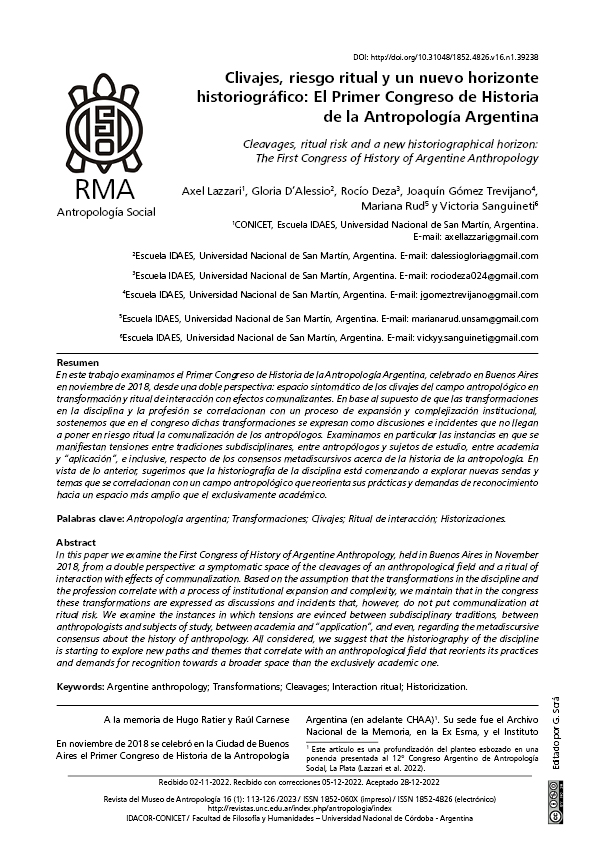Cleavages, ritual risk and a new historiographical horizon
The First Congress of History of Argentine Anthropology
DOI:
https://doi.org/10.31048/1852.4826.v16.n1.39238Keywords:
Argentine anthropology, Transformations, Cleavages, Interaction ritual, HistoricizationAbstract
In this paper we examine the First Congress of History of Argentine Anthropology, held in Buenos Aires in November 2018, from a double perspective: a symptomatic space of the cleavages of an anthropological field and a ritual of interaction with effects of communalization. Based on the assumption that the transformations in the discipline and the profession correlate with a process of institutional expansion and complexity, we maintain that in the congress these transformations are expressed as discussions and incidents that, however, do not put communalization at ritual risk. We examine the instances in which tensions are evinced between subdisciplinary traditions, between anthropologists and subjects of study, between academia and “application”, and even, regarding the metadiscursive consensus about the history of anthropology. All considered, we suggest that the historiography of the discipline is starting to explore new paths and themes that correlate with an anthropological field that reorients its practices and demands for recognition towards a broader space than the exclusively academic one.
Downloads
References
AA.VV. (Patricia Arenas y Elvira Baffi; Martha Blache; María Teresa Boschín; Raúl Carnese, José Cocilovo y Alicia Goicoechea; Alberto Rex González, Edgardo Garbulsky, Laura Raquel Piaggio, Miguel Ángel Palermo) (1992). Número especial sobre la historia de la antropología en la Argentina. Runa 20 (1).
Bartolomé, L. (1980). La Antropología en Argentina: Problemas y perspectivas. América Indígena XL (2), 207-215.
Bartolomé, L. (2007). Argentina: la enseñanza de la antropología social en el contexto de las ciencias antropológicas. Informe para la investigación A Distributed and Collective Ethnography of Academic Training in Latin American Anthropologies. Latin American Working Group of the WAN Collective.
Bórmida, M. (1958-59a). El estudio de los bárbaros desde la antigüedad hasta mediados del siglo XX. Bosquejo para una historia del pensamiento etnológico. Anales de Arqueología y Etnología 14-15, 265-318
Bórmida, M. (1958-59b). Bosquejo para una historia general del pensamiento etnológico. IIª parte. La Antropología del Materialismo. Runa 9 (1-2). https://doi.org/10.34096/runa.v9i1-2.4548
Boschín, M. & Llamazares, A. M. (1984). La escuela histórico-cultural como factor retardatario del desarrollo científico de la arqueología argentina. Etnía 32, 101-156.
Bourdieu, P. (2002). Campo de poder, campo intelectual: itinerario de un concepto. Montressor.
Centro Argentino de Etnología Americana (CAEA) (1985). Antropología. En AA.VV, Evolución de las Ciencias en la República Argentina 1872-1972.Vol 10. Sociedad Científica Argentina.
Collins, R. (2009). Cadenas de rituales de interacción. Anthropos.
Fernández, J. (1982). Historia de la Arqueología argentina. Asociación Cuyana de Antropología.
Garbulsky, E. (1987). José Imbelloni: positivismo, organicismo y racismo. Rosario: Universidad Nacional de Rosario.
Guber, R. & Visacovsky, S. (1999). Controversias filiales: la imposibilidad genealógica de la antropología social de Buenos Aires. Relaciones de la Sociedad Argentina de Antropología 22-23, 25-53.
Herrán, C. (1985). Antropología Social en la Argentina: Apuntes y perspectivas. Simposio sobre teoría e investigación de la Antropología Social Mexicana, El Colegio de México. Mayo 11-14.
Imbelloni, J. (1950). Antropología. Investigadores e investigaciones. Etapas de esta ciencia en nuestro país. Primer Ciclo Anual de Conferencias. Subsecretaría de Cultura, Ministerio de Educación. Volumen 1.
Lafon, C. (1976). Nociones de introducción a la antropología. Glauco.
Lazzari, A. (2002). Indio Argentino, Cultura (Nacional): del Instituto Nacional de la Tradición al Instituto Nacional de Antropología (1943-1976). En Rosana Guber y Sergio Visacovsky (Eds.), Historias y estilos etnográficos en la antropología argentina, (153-201). Buenos Aires: Antropofagia.
Lazzari, A., D’Alessio, G., Devoto, M. B., Deza, R., Gómez Trevijano, J., Rud, M., Sanguineti, V. (2022). Clivajes y situaciones en las prácticas de historización de la antropología argentina: un vistazo preliminar del Primer Congreso de Historia de la Antropología Argentina. Actas del XII Congreso Argentino de Antropología Social (CAAS) http://sedici.unlp.edu.ar/handle/10915/134724
Madrazo, G. (1985). Determinantes y orientaciones en la Antropología Argentina. Boletín del Instituto Interdisciplinario de Tilcara 1, 13-56.
Name, M. J. (2012). La historia que construimos. Reflexiones a propósito de una investigación sobre la Historia de la Antropología en la Argentina. Runa 33 (1), 53-69. https://doi.org/10.34096/runa.v33i1.339
Name, M. J. (2015). El campo de estudios de la historia de la antropología en la Argentina: panorama y debates actuales. Tabula Rasa 23, 157-179. https://doi.org/10.25058/20112742.45
Ramundo, P. (2012). Arqueología argentina: Pampa y Patagonia en perspectiva histórica”. AtekNa 2, 75-120. https://www.plarci.org/index.php/atekna/article/view/123
Tiscornia, S. & Gorlier, J. C. (1984). Hermenéutica y fenomenología: exposición crítica del método fenomenológico de Marcelo Bórmida. Etnía 31, 20-38.
Vessuri, H. (1995). Estilos nacionais da antropologia? Reflexoes a partir da sociologia da ciencia. En Roberto Cardoso de Oliveira y Guillermo Ruben (Orgs.). Estilos de antropología (155-176). Editora da Unicamp

Downloads
Published
Issue
Section
License
Copyright (c) 2023 Axel Lazzari, Gloria D'Alessio, Rocío Deza, Joaquín Gómez Trevijano, Mariana Rud, Victoria Sanguineti

This work is licensed under a Creative Commons Attribution-NonCommercial-ShareAlike 4.0 International License.
Those authors who have publications with this Journalaccept the following terms:
a. Authors will retain their copyrights and guarantee the journal the right of first publication of their work, which will be simultaneously subject to the Creative Commons Attribution License (Licencia de reconocimiento de Creative Commons) that allows third parties to share the work as long as its author and his first publication in this journal.
b. Authors may adopt other non-exclusive licensing agreements for the distribution of the version of the published work (eg, deposit it in an institutional electronic file or publish it in a monographic volume) provided that the initial publication in this journal is indicated.
c. Authors are allowed and recommended to disseminate their work on the Internet (eg in institutional telematic archives or on their website) before and during the submission process, which can lead to interesting exchanges and increase citations of the published work. (See The Effect of Open Access - El efecto del acceso abierto)











